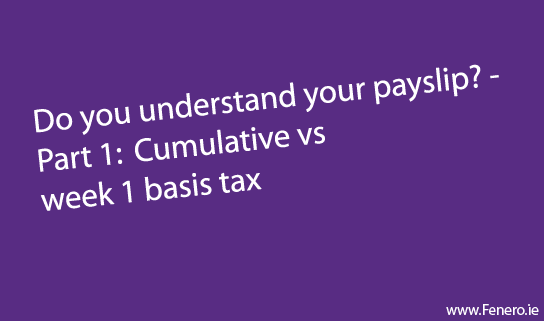After working hard all week or month, it’s finally pay day! But when you get your payslip and see all those tax deductions, do you ever wonder if the right amount is being taken off you? Nobody ever sits down to really tell you how to read a payslip, it is not something we are taught at school for example. For many people therefore it is a little bit of a mystery and trust is placed in employers to make calculations accurately and in Revenue to provide the correct information to employers. To help you spot when this system is not working quite as it should, getting yourself armed with a few of the knowledge basics is important. In this, the first of a series of articles on better understanding your payslip, we cover the difference between the Cumulative and the Week 1 basis of tax.
The Cumulative and the Week 1 basis of tax are the most common methods of calculating payroll taxes. There are a couple of others, for example emergency tax, but they tend to arise only in very specific situations and are not covered by this article.

What is the Cumulative basis of tax?
Applying the Cumulative basis of tax, means that a person’s tax liability is not calculated on the payment they receive each month/week in simple isolation. Instead, it works by calculating the tax liability arising on a person’s total income from the start of the tax year. The tax which must be deducted in each pay period is the cumulative tax due from 1 January to that date, reduced by the amount of tax already deducted in other pay periods.
Under the Cumulative basis, if a tax credit and/or a standard rate cut-off point are not used in full in a pay period, the unused portion can be carried forward and is used to reduce taxes payable in a subsequent pay period.
Cumulative basis allows your employer to pay you tax refunds which you may be due as the year goes along and means you do not have to wait until the end of the year to apply directly to Revenue.
What is the Week 1 basis of tax?
The Week 1 basis is also known as the Month 1 basis. Week 1 basis refers to people who are paid weekly. Month 1 basis refers to people who are paid monthly. They are however the same thing.
Essentially Month 1/Week 1 basis means that your taxes for each pay period are calculated completely in isolation and do not factor in anything else that has happened during the year up to that point.
The implication of this is that if you had not fully utilised all tax credits and allowances in the year, the tax calculations on your payslip would not take this into account. This means you would be overpaying tax. You can of course apply for a refund at the end of the year but most people would prefer to not overpay and instead have the benefit of the extra money in their bank account as quickly as possible. The other risk is that people do not realise they have overpaid and do not apply to Revenue for a refund at the end of the year.
ILLUSTRATION
Say for example your monthly tax credits are €275. Say also that you finished your last job in June and in July you had no work. You started your new job in August.
If you are taxed on a Cumulative basis, your August payslip will be calculated by including your August tax credits and also the unused July tax credits. Therefore you will get extra tax credits in August and pay a lower amount of tax.
However if you are taxed on a Week 1 basis, your August payslip will be calculated on the basis of your August tax credits alone. The unused tax credits for July are ignored. Therefore you would pay a higher amount of tax in August than you would if you had instead been taxed on a Cumulative basis.

How do Revenue decide when to apply Cumulative basis instead of Week 1 basis?
The Cumulative basis of tax should be the normal position for most people. However there are a range of circumstances in which the Week 1 basis is applied, which means that a substantial number of people are being taxed on a Week 1 basis.
The most common time when Week 1 is applied is where a person is switching employments and Revenue have not been provided with sufficient details of the person’s prior employments or prior earnings in the year. Generally this is very easily and promptly rectified by ensuring that Revenue receive your P45 from your last employment.
A call to Revenue’s PAYE Helpline will give you the reason that you are on a Week 1 basis and let you know how this can be rectified if you wish to move to a Cumulative basis.
If I am on a Week 1 basis, can I switch to a Cumulative basis?
As long as you can resolve the reason why Revenue have placed you on a Week 1 basis in the first place, then yes you certainly can switch. Often it is simply a case of Revenue needing you to contact them to provide missing information or answer simple queries which enables them to take you off Week 1 basis.
Is it a good idea to try and switch to Cumulative from Week 1?
Firstly, think about what it means to be taxed on a Cumulative basis. As outlined above, this means that all your earnings and tax credits/allowances for the year are taken into account as each payslip is processed. If it is the case that you have unused tax credits/allowances then you will get the benefit of these more or less straight away when you switch to Cumulative. This saves you waiting until the end of the tax year to get a tax refund.
However if it were the case that you had not paid enough taxes earlier in the year for any reason, this will be calculated in your payslip after you switch to Cumulative and the underpaid taxes will be deducted from your pay. If you had not realised you had underpaid taxes, it could come as a bit of a shock when you receive your payslip and your net take home pay is below what you were expecting.
An underpayment of taxes may arise where your employer was making errors in your payslip calculations or where Revenue had advised your employer to use a certain amount of tax credits which were later found to have been too high. Corrections for underpaid taxes for the year will be included in your first payslip after you switch to a Cumulative basis.
If it is identified however that switching to a Cumulative basis will result in a large sudden clawback of underpaid taxes, an arrangement can sometimes be made with Revenue to leave you on a Week 1 basis if this clawback will cause financial hardship. Note this is a temporary arrangement only however as you will still be required to sort out the underpaid taxes at some point. However remaining on Week 1 may allow you a bit of breathing space to work out how to deal with affording to repay the underpaid taxes.
How do I find out if I am taxed on a Cumulative basis as opposed to a Week 1 basis?
It should be clearly stated somewhere on your payslip whether you are on a Cumulative or Week 1 basis. The words Cumulative or Week 1 (or Month 1) should appear quite clearly. Although be aware that sometimes abbreviations are used. For example, Cumulative may appear as “Cumul”. Every payroll software is slightly different and will lay out standard payslip information in different places and in slightly different ways. Where used however, abbreviations are generally not too cryptic and you should be able to identify and interpret them quite quickly.







